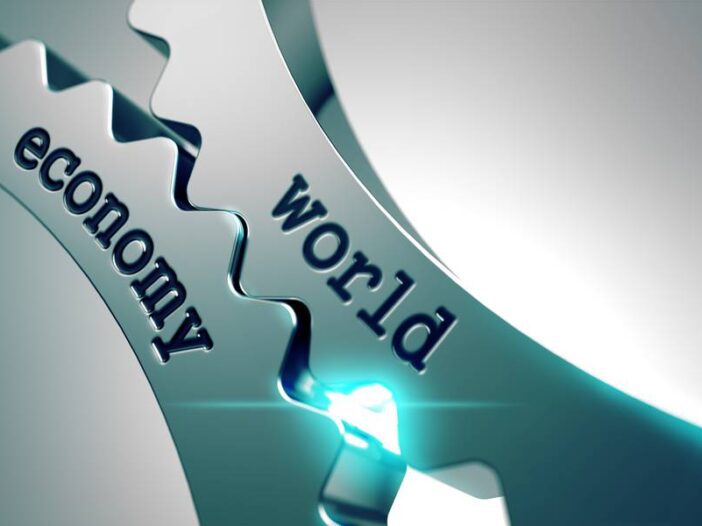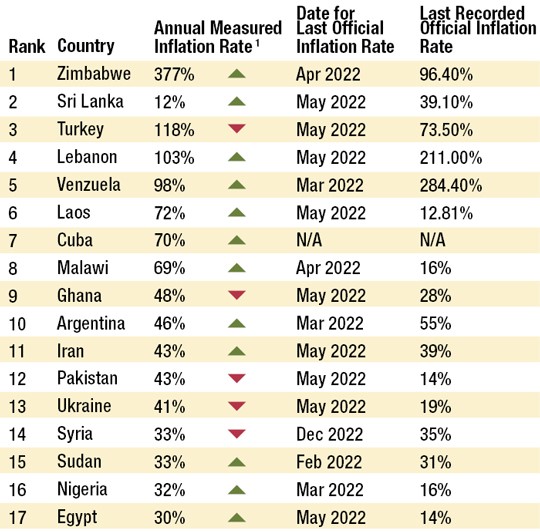Investors should understand that the inflation and high interest rate dilemmas discussed in previous articles aren’t confined to major developed economies or developing giants such as China. The problem of inflation is global and is even more acute in important developing economies, as shown in the chart below from Steve Hanke of Johns Hopkins University.
Among economists, Hanke is the leading expert and tracker of inflation and hyperinflation in the world:
|
|
| Source: Computed by Steve H. Hanke, The Johns Hopkins University. |
Perhaps seeing Zimbabwe at the top of the list, with 377% annual inflation, comes as no surprise. What may be surprising is the high inflation in several developing economies that are significant in overall global rankings.
Turkey is the 23rd largest economy in the world (US$692 billion GDP) and has 118% inflation. Argentina is the 26th largest economy in the world (US$564 billion GDP) and has 46% inflation. Nigeria is the 31st largest economy in the world (US$510 billion GDP) and has 32% inflation. Other relatively large economies that make this high inflation list include Egypt, Venezuela, and Pakistan.
More to the point, the combined population of these high-inflation countries is more than one billion people or 12.5% of the total population of the planet. Their ability to withstand high interest rates and economic recession to fight inflation is extremely limited. As these high rate, lower-growth policies roll out around the world, the potential for humanitarian crises, including mass starvation and social unrest, cannot be overstated.
The domino effect of a worldwide slowdown
This survey has considered the US, UK, the EU (especially Germany), China, and Japan. Those are the five-largest economies in the world and have a combined GDP of US$70 trillion, which comprises 75% of global GDP.
Clearly, there are other important economies in the world including India, Canada, Brazil, and Russia. And clearly there are other powerful factors driving the global economy; including supply chain dysfunction, the war in Ukraine, the economic war that has emerged from the Western response to the invasion, and the role of Russia as a supplier of critical commodities including oil, natural gas, coal, wheat, and strategic metals.
Also, investors shouldn’t overlook the extensive efforts to get out from under dollar hegemony through the creation of new payment channels and new reserve currencies including those currently underway by the BRICS (Brazil, Russia, India, China, and South Africa), the Shanghai Cooperation Organisation, and large buyers of gold, including Russia, China, Turkey, and Iran.
Still, our sample is more than enough to identify the key trends and connections affecting global growth. Those trends break into three cases: The first case consists of the majority of developed economies (US, EU, UK, Australia, Canada, and others) that are experiencing high inflation and higher interest rates imposed in an effort to destroy demand and subdue inflation. The likely outcome for this case will be a recession, not a soft landing.
Inflation will come down by next year, but so will the valuations of stocks and other asset bubbles. A recession is the best outcome. A severe recession combined with a financial and liquidity crisis is a distinct possibility.
The second case only has one member — Japan. Its inflationary trends will persist because monetary ease will persist at least until 2023. A recession cannot be ruled out, even with monetary ease, because recessions are more the norm than the exception in Japan — and because Japan is highly dependent on growth in other developed economies that are slowing down. The main impact for investors will be a rapidly depreciating yen. The USD/JPY cross rate will sink to 140 or lower in the months ahead.
The final case also has one member — China. Its economic slowdown has already occurred and will get worse. The policy response is monetary ease and a weakening of the yuan against the dollar. China will continue to wreck its own economy with its ‘Dynamic Zero’ COVID policy. These adverse conditions will persist at least until the 20th National Party Congress in November 2022, which will appoint Chairman Xi to an unprecedented third term as president and elevate him to the status of Mao Zedong.
Whether China will try to change course after November is unknown — but it’ll be too late in any case. By then, the collapse will be embedded and recession in the rest of the world will ensure China gets no help from external demand.
[Note: This was originally punished in July 2022.]
National economies and economic groups such as the EU have idiosyncrasies and indigenous factors that drive economic performance. Still, the global interconnections tend to be more powerful because of exchange rate and interest rate channels. Events really are interconnected in the end. That’s what we’ve tried to convey to you, the reader, with this global survey.
We’re on a global roller coaster going from inflation and high rates to deflation and recession in record time. Only the nimble investor will be able to enjoy the ride.
Diversification is key as markets can turn quickly. Remember — cash, bonds, and hard assets like gold should be part of any portfolio during these volatile times.
All the best,
 |
Jim Rickards,
Strategist, The Daily Reckoning Australia
This content was originally published by Jim Rickards’ Strategic Intelligence Australia, a financial advisory newsletter designed to help you protect your wealth and potentially profit from unseen world events. Learn more here.


